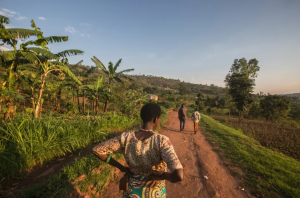Here’s an absolutely fascinating look at wax prints — what we journalists like to describe as “colorful African fabrics.” I still haven’t come up with a better shorthand; anything more becomes a soliloquy to the incredible colors and creative and sometimes bizarre patterns in the cloth — and, if you’re writing about someone who can afford a good tailor, the place-specific styles into which they are stitched.
CongoStory, an organization about which I know absolutely nothing, recounts the rise of the “African fabric” — which anyone who’s spent time out here will know is usually, actually, Dutch:
The short version of its history goes like this: the Dutch learned about batik from the Indonesians and imitated this process, hoping to factory-produce similar fabric at a cheaper price. Like a mid-1800s version of Walmart, their success would have run the local, traditional artisans out of business, but the Indonesians turned up their noses at the Dutch copies, preventing such a fate. Then, laden with unsold fabrics, Dutch ships found a market for their product in another portion of their trade route: the African “gold coast” (Ghana).
Sprinkled throughout the post are fascinating details: In the 1980s, women who sold the high-end fabrics from Holland were called “Nana Benz,” because the business earned enough to buy a Mercedes. There’s a fabric whose pattern is called “money flies,” because the symbol of Super Wax fabrics (creme de la creme) is a bird. There’s surprises, like this one:
…[T]he image of a caged bird has been used heavily in Western fiction to symbolize forms of oppression[;] some looking at the design on the right might be tempted to read this image as a celebration of freedom. However, in this case, flying out is a sign of trouble; the pattern’s name delivers a sassy dissuasion to would-be cheaters: “You go out, I go out!” Meanings like this reflect not only historically eventful but domestic, everyday things happening in the lives of those who are selling and wearing the design. This is an area of expression particularly open for women to voice opinions and concerns, as the designs we’ve examined suggest.
I suppose such armchair sociological thought is open to debate, and CongoStory doesn’t attribute any of these facts, so I don’t know where the got them or what else they’ve examined. But it’s still a great read. And buried toward the bottom is a bit of information on artist Yinka Shonibare, whose meditations on identity, history, and economic and political power take shape in Dutch waxes.




You’re absolutely right–I have to finish embedding my source links so people can see where I’ve pulled some of my information; this will help readers continue exploring, if they like–or at least allow them to verify my sources. While many sociological meanings of the cloth patterns may be up for debate, the ones I named are those I judged to have reasonably stable meanings. Thank you for drawing people’s attention to my article and reminding me that I need to embed those links.
As a short intro for anyone curious, CongoStory is the informative arm of a 501 c3 nonprofit (the Congolese Advocacy Memorial Project Fund) that we started in my father’s honor in 2009 to cultivate partnerships with excellent problem-solvers and care-givers in DRC. We have a family history of service in DR Congo stretching back to 1917, and this site started as a way to give donors rich connections to the DR Congo–material from our four generations of experience there as well as information that comes from our current advocacy and education efforts; we started this site because we believe in the importance of giving good information and the power of story to help share that information effectively and responsibly. If you want to know more, you can read the about section on the site. I’m the main author–so if you have questions or comments, they’ll come straight to me.